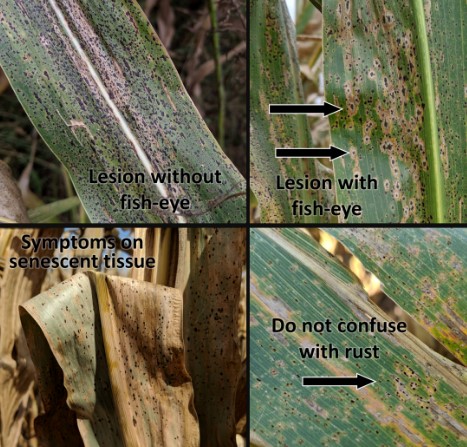By Pierce Paul, Felipe Dalla Lana da Silva
Tar Spot, a new disease of corn caused by the fungus Phyllachora maydis, was reported for the first time in Ohio at the end of the 2018 growing season. At that time, it was found mostly in counties close to the Indiana border, as the disease continued to spread from the middle of country where it was first confirmed in 2015. Over the last few weeks, there have been several new, confirmed report of Tar Spot in Ohio, this time not only in the northwestern corner of the state, but also from a few fields in central and south-central Ohio. As was the case last year, disease onset was late again this year, with the first reports coming in well after R4. However, some of the regions affected last year had more fields affected this year, with much higher levels of disease severity. It could be that Tar Spot is becoming established in some areas of the state due to the fungus overwintering in crop residue from one growing season to another. This is very consistent with the pattern observed in parts of Indiana and Illinois where the disease was first reported. We will continue to keep our eyes out for Tar Spot, as we learn more about it and develop management strategies. You can help by looking for Tar Spot as you walk fields this fall, and please send us samples.

What does it look like? Even though corn is drying down, if Tar Spot is present, you can still detect it on dry, senescent leaves almost as easily as you can on healthy leaves. So, please check your fields to see if this disease is present. “Symptoms of tar spot first appear as oval to irregular bleached to brown lesions on leaves in which raised, black spore-producing structures call stroma are formed... giving the symptomatic areas of the leaf a rough or bumpy feel to the touch… resembling pustules on leaves with rust. Lesions … may coalesce to cause large areas of blighted leaf tissue. Symptoms may also be present on leaf sheaths and husks.” As the name of the disease suggests, symptoms look like the splatter of “tar” on the leaves. In some cases, each black tar-like spot may be surrounded by a necrotic halo, forming what is referred to as “fish-eye” lesions.
What causes Tar Spot and how damaging is it? In the past, the greatest impact of this disease in terms of yield loss were observed when P. maydis-infected plants were co-infected with a second fungus called Monographella maydis. In other words, the damage tended to be much more severe when the two fungi worked together to affect the plant. So far, only the first fungus, P. maydis, has been reported in the US, but based on work done in Illinois, this pathology alone is capable of causing substantial yield reduction on highly susceptible hybrids when conditions are favorable and infections occur early.
Where did it come from and will it survive and become established? At this point it is still unclear as to how Tar Spot got to the US in the first place and how it continues to spread. The fungus is not known to be seed-borne or infect other plant species, so corn seeds and weeds are unlikely to be the sources of inoculum. However, the fungus can survive and be moved around on fresh and dry plant materials such as leaves and husks. In addition, since spores of the fungus can be carried be wind, it could be blowing in from neighboring states/counties/fields. Although not yet confirmed through survival studies, it appears that the fungus could be overwintering in infected crop stubble between growing seasons.
What should I do if I find Tar Spot? If you see anything that fits the description of, or resembles (Picture) Tar Spot, please inform your state specialist, field specialist, or county extension educator, but most importantly, please send samples to my lab (1680 Madison Ave, Wooster, OH) for confirmation. We will also be using your samples to study the fungus in order to develop effective management strategies.
Source : osu.edu